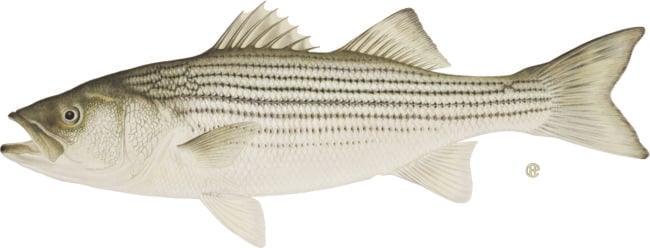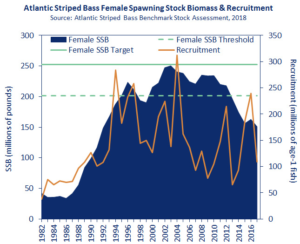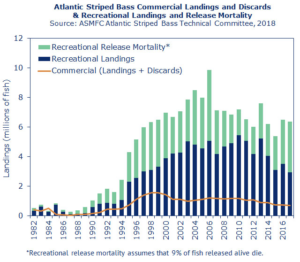Hudson River striped bass fishing – What you need to know

New York State Department of Environmental Conservation
View more images on our Flickr site
Stripers are in decline coastwide, and changes are coming. If you enjoy fishing on the Hudson, it’s time to become more informed.
UPDATE, May 15, 2023
Important news: Emergency action to change slot limits for striped bass
On May 2, 2023, the Atlantic States Marine Fisheries Commission (ASMFC) Striped Bass Management Board voted to take emergency action to implement a 28-inch to less than 31-inch size slot limit for all ocean recreational striped bass fisheries coastwide.
Currently, slot limits for striped bass caught in the Hudson River north of the George Washington Bridge (18 inches – 28 inches) are different from striped bass caught in marine waters. Riverkeeper will be tracking any additional changes to the Hudson River slot limits as a result of this emergency action and keep our community informed.
The new action by ASMFC responds to the unprecedented magnitude of the 2022 recreational harvest, which nearly doubled from 2021, and new projections indicating that the stock has a very low chance of rebuilding if the 2022 fishing mortality rate continues. The 31-inch size restriction is designed to reduce harvest on the 2015 year-class, one of the last strong year-classes in the population.
States must implement compliant measures as soon as possible and no later than July 2, 2023 — or risk being found out of compliance and having a full harvest moratorium enacted. The emergency action will be in place for 180 days but could be extended by the Board.
Until the new regulation is formally adopted by states, the current striped bass regulations remain. However, in order to maximize the conservation benefit, anglers are encouraged to release all fish 31 inches or greater immediately.
The Board also voted to examine additional measures for 2024 if needed to meet a 2029 deadline to rebuild striped bass. This will be a fully public process and consider changes to both the recreational and commercial regulations.
Four virtual public hearings will be held to inform the public in New York about this emergency action – May 17, May 22, May 23, and May 31. Get more information or register for a hearing online here.
The regulations for striped bass in New York will not change until the emergency regulation is passed. Once state regulations are put into effect, DEC will seek public comment. Anglers are encouraged to continue to check DEC’s webpage for the current limits in effect.
Tell Gov. Hochul to block invasive species at the Erie and Champlain canals
 Prevent the invasion of jumping carp, which could radically damage the striped bass fishery. Send a message to Gov. Hochul asking for action to block invasive species from using the Erie Canal to reach the Hudson.
Prevent the invasion of jumping carp, which could radically damage the striped bass fishery. Send a message to Gov. Hochul asking for action to block invasive species from using the Erie Canal to reach the Hudson.
April 2022
Another striper season is approaching on the Hudson. This prized and celebrated fish will be streaming throughout the estuary when the forsythia begin to bloom.
But as we’ve learned, the coastwide abundance of striped bass is on the decline, according to the Atlantic States Marine Fisheries Commission. New steps will be, and must be, taken to protect this iconic species along the entire East Coast. And all of us need to become well informed.
 The commission completed a coastwide stock assessment last fall that showed striped bass in decline and overfished. More specifically, the “spawning stock biomass,” or the portion of the population able to reproduce, has been in decline since 2004. The numbers are so low that the commission is required to act, in coordination with states, to prevent further declines.
The commission completed a coastwide stock assessment last fall that showed striped bass in decline and overfished. More specifically, the “spawning stock biomass,” or the portion of the population able to reproduce, has been in decline since 2004. The numbers are so low that the commission is required to act, in coordination with states, to prevent further declines.
If you fish along the Hudson, you have a role to play here. Commercial fishing for stripers ended on the Hudson in 1976, when the fish were found to contain high levels of PCBs released by General Electric. Recreational fishing is enjoyed and celebrated throughout our region – subject to limits. In the Hudson River and tributaries north of the George Washington Bridge from April 1 through November 30, registered anglers may keep one fish measuring between 18 and 28 inches. [Also, see health advice on eating fish from the Hudson; children and women of childbearing years should eat no fish.]
One thing you can do is be sure to use non-offset circle hooks when fishing for striped with natural baits. Non-offset circle hooks cause less injury by preventing damage vital organs and give stripers a better chance of surviving after being caught & released. Anglers can always choose to crimp hook barbs to facilitate removal and causing less damage to the fishes mouth when removing hooks. Good angling techniques can offset the need for a barbed hook.
What forces are pushing the striped bass populations into decline?
 While commercial harvests coastwide have undoubtedly played a role in the stripers’ decline, ASMFC has determined that the recreational harvest and catch-and release fishing are causing the majority of striped bass mortality.
While commercial harvests coastwide have undoubtedly played a role in the stripers’ decline, ASMFC has determined that the recreational harvest and catch-and release fishing are causing the majority of striped bass mortality.
Ranging from North Carolina to the Canadian Maritimes, stripers move in from the ocean to spawn, and quickly return to the ocean to chase their favored prey. Most stripers originate in the rivers that drain into the Chesapeake Bay region, but the Hudson River Estuary forms the second largest spawning grounds for these fish, with the Delaware River contributing to the stock as well.
Mortality rates during angling in freshwater, especially with the use bait such as herring, can exceed 15 percent – meaning that 15 of 100 fish caught by anglers die from stress from over-exertion or from hooks that are swallowed, damage organs, or cut the gill filaments after they are released. Mortality rates will increase with rising water temperatures, because low dissolved oxygen levels occurring in warmer waters add further physiological stress on the fish.
Many people are adopting less harmful practices in catch-and-release fishing. But now is the time to educate others who are not yet in the habit.
Rough handling, prolonged exposure out of water, and careless hook removal place additional stresses on the fish.
Fish require oxygen to recover and survive, so it is best not to take a fish to be released out of the water. Lifting an exhausted fish out of the water is like placing a plastic bag over the head of a sprinter who just ran a race. Fish that are visibly stressed should be kept in the water and moved back and forth, allowing water to pass over their gills to revive them, until the fish can swim on its own.
Here are some guidelines for anglers:
• Use proper weight-class tackle to avoid unnecessarily tiring the fish;
• Land your catch quickly, don’t “play” them too long;
• Leave the fish in the water as it is being released;
• Use inline circle hooks when using bait;
• Do not use the use treble hooks;
• Replace treble hooks on lures with single shanked hooks
• Always use a net when removing a fish from the water (Gaffs are prohibited in freshwater);
• Crimp your barbs to reduce damage to the fish when removing hooks. Proper angling technique prevents the need to use barbed hooks. Maintaining tension on the line at all times can prevent the fish from shaking the hook, even barbless ones;
• When taking photos of fish to be released, the goal is to get the fish back in the water promptly.
These individual actions are essential, but larger actions will be needed.
The ASMFC is studying ways to reduce coastwide mortality, and decisions will ultimately impact both recreational and commercial fisheries. For example, it is expected that ASMFC will be seeking a 17 percent reduction in fishing mortality that will be shared by both the commercial and recreational fisheries. It is likely that there will be a coastwide requirement for circle hooks when bait fishing.
In Virginia, fishery managers eliminated their spring trophy season that runs from May 1 to June 15 and specifically targets fish that 36 inches or larger. The reason for protecting these large fish is that they are the egg-laden females – the future of the species. Anglers there are now allowed two fish per day that fall into the 20- to 28-inch category.
The public will have a chance to weigh in on any decisions to come. Clearly, action must be taken to reduce mortality on all life stages of striped bass, but especially on the spawning stock, and most specifically on pre-spawn fish, in order for the stock to rebound.
The message is simple: If we want more fish, we need to stop killing so many fish.
Please support the use of circle hooks and give the striped bass population a fighting chance.
Learn more about Saving Hudson River Fish >
